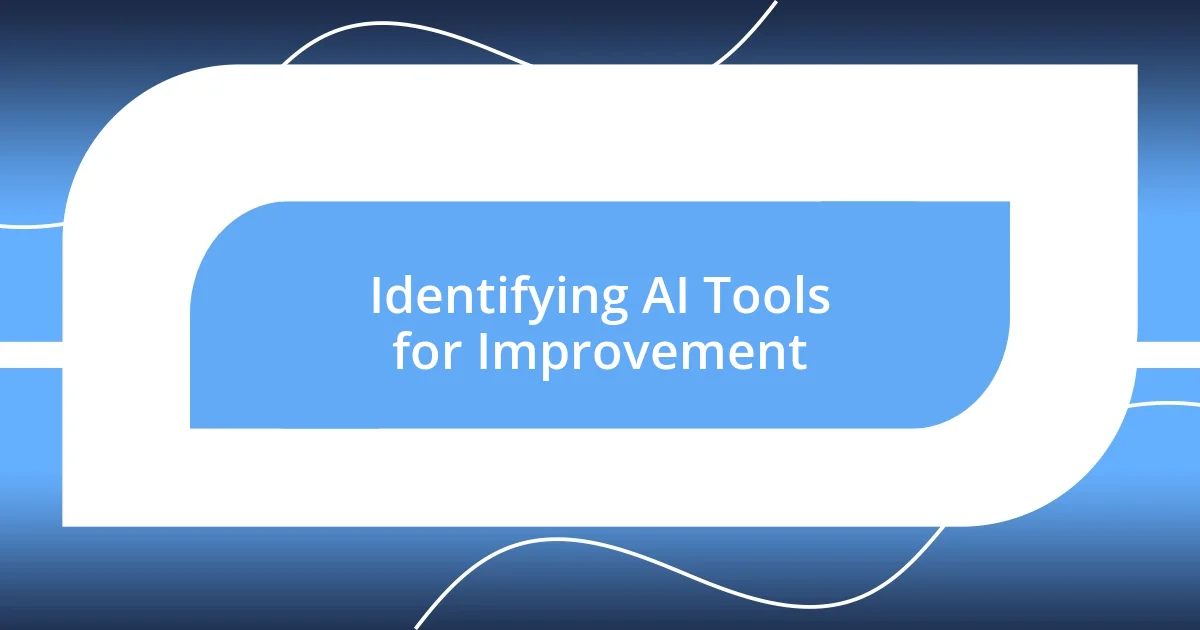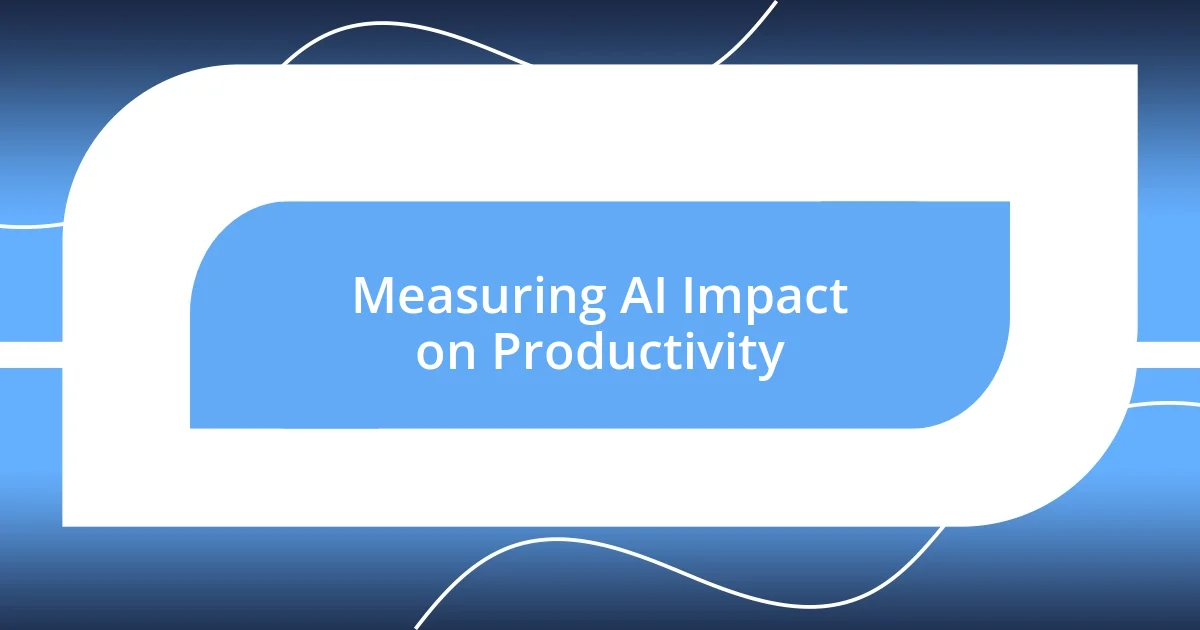Key takeaways:
- AI enhances both efficiency and creativity, allowing users to focus on strategic decision-making while handling mundane tasks.
- Identifying the right AI tools involves assessing workflow bottlenecks and experimenting with solutions tailored to specific needs.
- Continuous learning and adaptation to AI advancements are crucial for maximizing productivity and uncovering new opportunities in workflows.

Understanding AI in Workflows
When I first started incorporating AI into my workflow, I experienced a sense of curiosity tinged with skepticism. Would this technology really make a difference, or would it complicate things further? As I began to explore AI-driven tools, I was surprised to find how quickly they streamlined tedious tasks, freeing up my time for more creative pursuits.
There was one moment that stands out vividly. I was working late on a project with a near-imminent deadline. Frustrated and overwhelmed, I decided to give an AI writing assistant a try. To my astonishment, it generated insights and suggestions that not only saved me hours but also sparked new ideas I hadn’t considered. This experience made me realize that AI isn’t just about efficiency; it can enhance creativity, too.
As I delved deeper into understanding how AI integrates into workflows, I asked myself: what aspects of my processes could truly benefit from this technology? I quickly learned that AI can analyze data patterns and workflows far more efficiently than we humans can. This revelation allowed me to focus on strategic decision-making instead of getting lost in the minutiae, transforming the way I approached my work.

Identifying AI Tools for Improvement
Identifying the right AI tools for improvement requires a thoughtful approach. In my journey, I found it essential to first assess my workflow to pinpoint bottlenecks or repetitive tasks that drained my energy. Once I recognized these pain points, I could seek out tools that specifically addressed them, leading to immediate enhancements in my efficiency. For example, implementing an AI project management tool transformed my task organization and communication with team members.
Here are some key areas to focus on when identifying AI tools for your workflow:
- Task Automation: Look for tools that can take over repetitive tasks, like scheduling or data entry.
- Data Analysis: Consider solutions that analyze large data sets, providing insights that would take much longer to glean manually.
- Collaboration: Seek out AI tools that enhance team collaboration, making it easier to share ideas and track progress in real time.
- Creative Assistance: Explore writing assistants or content generators that can help spark creativity and overcome writer’s block.
- Customer Interactions: Investigate chatbots or customer service AI to streamline client communications and improve response times.
Finding the right AI tools requires patience and experimentation. I vividly remember feeling overwhelmed by choices at first. But as I gradually implemented AI solutions that aligned with my specific needs, I experienced a surge in productivity and satisfaction in my work life. The key was to remain open-minded and ready to adapt, allowing AI to enhance my workflow in ways I hadn’t initially anticipated.

Integrating AI into Daily Tasks
Integrating AI into my daily tasks has revolutionized how I operate. For instance, I remember the exhaustion of sifting through countless emails every morning. By employing an AI email sorting tool, my inbox transformed from a chaotic mess into a neatly organized space where priority emails stood out. This small change not only saved me time but also drastically reduced my stress levels—an unexpected yet welcome boost to my daily routine.
As I implemented various tools, I experienced a truly enlightening moment with an AI scheduling assistant. Initially, I was skeptical about letting a machine handle my calendar. However, watching it effortlessly sync my meetings with colleagues across time zones was a revelation. The AI managed to identify gaps in my schedule, suggesting optimal times for collaboration. It felt like having a personal assistant dedicated to ensuring my schedule was not just filled, but efficiently curated.
Memory serves me well when I think of the day I automated my reporting process with an AI analytics tool. For a long time, generating reports had been a painstaking, hours-long ordeal. With a few clicks, the AI analyzed my data and visualized trends I hadn’t even noticed before. I could finally focus on strategy instead of spending precious hours mired in data collection. That moment reignited my passion for my work, showcasing how AI doesn’t just make tasks easier; it enables deeper engagement with what truly matters.
| AI Integration Example | Outcome |
|---|---|
| Email Sorting | Streamlined workflow and reduced stress |
| Scheduling Assistant | Optimized meeting times and efficiency |
| Analytics Tool | Deeper engagement with strategic tasks |

Overcoming Challenges with AI
Embracing AI in my workflow was not without its hurdles. At first, I struggled to trust these tools fully. I remember the sinking feeling of doubt—would I lose control over my tasks by relying on a machine? It took me some time to realize that AI isn’t meant to replace my decision-making; rather, it can enhance my capabilities by taking over menial tasks. This transition felt less like capitulation and more like an empowering collaboration.
There were moments when my choice of tools didn’t align perfectly with my expectations. I once invested time in an AI tool that promised to streamline my data visualization. However, it became increasingly clear that it wasn’t suited for my unique needs. Frustrations crept in, but instead of giving up, I decided to pivot. That experience taught me the invaluable lesson of flexibility; not every tool will hit the mark, but each misstep brings me closer to the right one.
Reflecting on my journey, I also learned that overcoming challenges with AI often requires a blend of patience and curiosity. For example, the early days of engaging with an AI writing assistant were filled with skepticism and some humorous mishaps. I laughed when it produced sentences that were downright bizarre. However, by continually refining the prompts I provided, I saw a marked improvement in its suggestions. This taught me that AI requires ongoing interaction and learning, just like any relationship. What challenges have you faced with integrating AI, and how can you turn those challenges into opportunities?

Measuring AI Impact on Productivity
Measuring the impact of AI on productivity requires more than just observing time saved; it’s about noticing the qualitative changes in how I work. After integrating an AI task manager, I found that it didn’t merely help me track tasks; it reshaped my entire approach to project management. I could suddenly see which tasks were truly essential, leading me to prioritize my workload in ways I never had before—have you ever experienced that “aha” moment where clarity fosters better decision-making?
When I started using AI to handle routine customer inquiries, the change was nothing short of revolutionary. I remember the surge of relief when I saw response times drop significantly, allowing my team to focus on more complex issues. This shift not only improved client satisfaction but also cultivated a more engaged workforce. How often do we get stuck in the weeds of everyday tasks and forget to focus on the bigger picture?
Furthermore, I embraced metrics like the “time to completion” of projects driven by AI-assisted decisions. One memorable project saw a 30% reduction in turnaround time, but what truly amazed me was the boost in our team’s morale. It was invigorating to witness how quickly we could progress without sacrificing quality. Isn’t it remarkable how productivity can directly correlate with employee satisfaction?

Future-Proofing Your Workflow with AI
AI has not only streamlined my tasks but also shifted how I think about my workflow. I recall a hectic week when a project deadline was looming. Thanks to an AI scheduling assistant, I managed to reorganize my priorities in a way that felt almost liberating. Have you ever felt that rush of freedom when technology alleviates pressure? That’s precisely what I experienced.
Moreover, as I dove deeper into AI-driven analytics, I was fascinated by the tailored insights it provided. I’ll never forget the time I analyzed customer feedback trends with a tool I initially overlooked. It revealed patterns I hadn’t considered, changing the direction of our marketing strategy entirely. Isn’t it astonishing how AI can unearth hidden opportunities that we might miss?
Ultimately, the key to future-proofing my workflow lies in being open to continuous adaptation. I’ve learned that AI evolves, just as my needs do. By regularly revisiting and tweaking my AI tools, I ensure that they remain aligned with my goals. Have you evaluated how your current tools serve you lately? It’s a commitment to reflecting on what works and what doesn’t, keeping my workflow not just efficient, but also relevant.

Continuous Learning and AI Adaptation
Embracing continuous learning in my journey with AI has been a game changer, and I can’t stress enough how critical this mindset is. I still remember when I first tried out an AI-driven tool for content generation; it felt like stepping into a brand new world. Initially, I was overwhelmed by the possibilities, but with time, I realized that adapting meant more than just using AI—it involved actively seeking out new features and upgrades. Have you ever felt the thrill of mastering something new and watching your capabilities expand?
As I’ve navigated through various AI tools, I’ve seen that keeping up with their rapid evolution requires a proactive approach. I often set aside time each week to explore fresh tutorials and advancements in AI technology. It’s a bit like tasting a new dish; you never quite know how it’ll turn out until you give it a shot. Just recently, I stumbled upon an AI extension that enhanced my research capabilities significantly, saving me hours of initial data collection. When was the last time you discovered a tool that transformed how you work?
Adapting to AI is an ongoing conversation with the technology itself; it’s about being curious and flexible. I remember a project where I assumed I had mastered my AI analytics tool, only to find out that a simple update introduced powerful predictive features I had overlooked. This revelation not only enhanced our projections but also reinforced my belief that staying informed is essential. Isn’t it fascinating how the right mindset can open doors to unexpected enhancements in our workflows?














